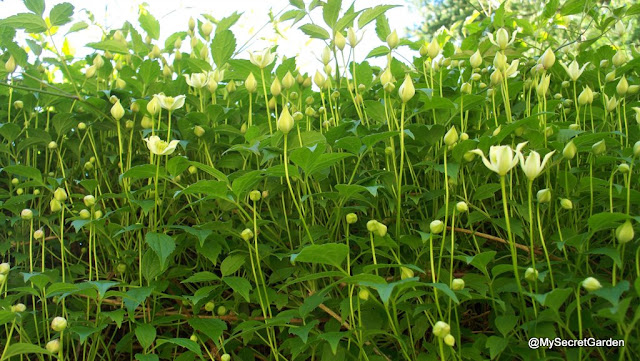The last morning in May.
Temperature at 7 a.m. was 55 degrees Fahrenheit (13 degrees Celsius).
Nice landscape:
I knew you'd click on this image!
Side view:
Some of them are stocked with trout and carp.
People saw them swooping down for a fish.
Rhododendrons are native in this area.
While rhododendrons and their azalea relatives are often considered to be southern shrubs, many rhododendrons are cold hardy as far north as the Ohio Valley, into southern Pennsylvania and along the Atlantic coast into New England (zone 5). Many manage well where winter temperatures seldom dip below -10°F. The climate in the Pacific Northwest is proving to be ideal for these shrubs.
I heard that the darker the color is, the more cold resistent a rhododendron is.
Another shade of yellow:

Rhododendrons are slow growers. Dwarf types may reach only 3" at maturity. Standard rhododendrons often grow as tall as 15 or 20 feet, and will spread equally wide.

Rhododendrons are called broadleaf evergreens. They have elegant leaves which are elliptical and usually a dark glossy green above and lighter and duller beneath. Unlike those of their azalea relatives, rhododendron leaves are smooth on top. Leaves of individual types of rhododendron may be anywhere from 2 to 10 inches long. The foliage of most species is evergreen and is an especially welcome sight in winter.

Flowers of standard rhododendrons are tubular, with spectacular flaring petals. They grow at the ends of branches in rounded bunches of 5 or 7 blooms. These clusters may be 6 to 10 inches across (3 to 6 inches for smaller types) and literally cover the shrubs in a gorgeous spring display. Appearing from early April (PJM hybrids) through May into early summer, various types of rhododendrons offer many colors. Flowers are often magenta or shades of purple, pink or red, or white, sometimes marked with interesting speckles and splashes of color. Breeders are working to develop some with yellow blossoms and more summer blooming types that will offer a show in late June or even July.
Rhododendrons steal the show this time of the year,
but water views are beautiful as well.
It was a wonderful morning.
Click on the pictures to enlarge them
The Rhododendron information is borrowed from here:
http://yardener.com/HomeGardening***Copyright TatyanaS
Golf Courses Art

















































